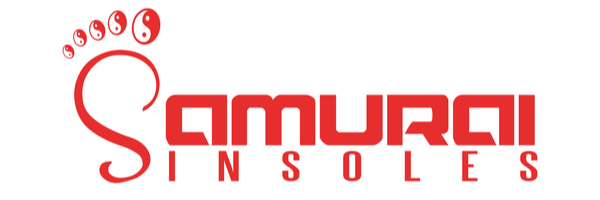If you've ever felt that sharp, stabbing pain in your heel—especially with those first few steps in the morning—you know exactly what plantar fasciitis feels like. It's a pain that's hard to ignore. The key to getting through it is to focus on two things right away: calming the immediate inflammation and taking the strain off that angry tissue. This starts with simple, proven methods you can do at home.
Finding Immediate Relief from Heel Pain
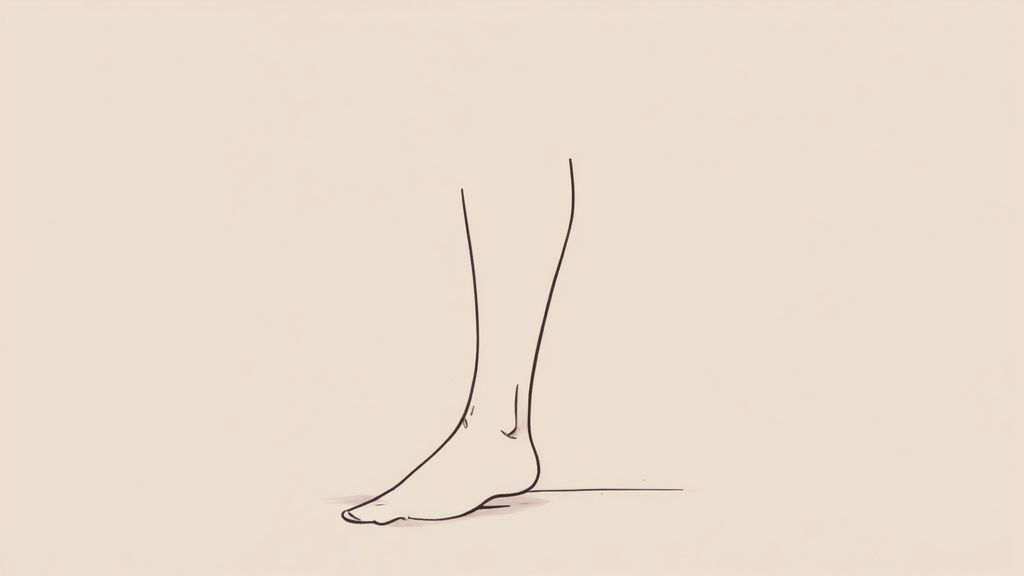
When a plantar fasciitis flare-up hits, your first thought is just to make the pain stop. This initial phase is all about damage control. It’s not about finding a magic bullet, but taking practical steps to dial down the acute inflammation so your foot can actually begin to heal. The goal is to get the pain under control so you can start the real work of stretching and strengthening.
If you’re dealing with this, you're in good company. Plantar fasciitis is incredibly common, affecting about 10% of the global population at some point in their lives. It’s particularly prevalent in adults between 40 and 60 and anyone who spends long hours on their feet.
The good news? Simple, at-home care works for most people. In fact, conservative treatments resolve about 80% of cases without needing more invasive procedures. You can explore more detailed statistics about this common condition to see just how widespread it is.
The R.I.C.E. Method for Your Feet
The classic R.I.C.E. method—Rest, Ice, Compression, and Elevation—is the gold standard for acute injuries, and it works just as well for an inflamed plantar fascia.
- Rest: This is non-negotiable. You have to reduce or stop the activities that are making your heel scream, like running, jumping, or standing all day on concrete. This doesn’t mean being chained to the couch, but you do need to be smart and give your foot a break.
- Ice: Ice is your best friend for fighting inflammation and numbing pain. Roll your foot over a frozen water bottle for 15-20 minutes a few times a day. It’s a fantastic two-for-one that combines icing with a gentle massage.
- Compression: A simple compression sock or an elastic bandage can help keep swelling down and give your arch a bit of support. Just make sure it’s snug, not tight—you don't want to cut off circulation.
- Elevation: Whenever you’re sitting down, prop your foot up. Getting it above the level of your heart helps gravity do its job, draining fluid away from your foot and reducing swelling.
Key Takeaway: The R.I.C.E. method isn’t just for a sprained ankle. Being consistent with it during a plantar fasciitis flare-up is one of the most powerful things you can do to manage the initial pain and set the stage for healing.
Mastering Simple Foot Rolling Techniques
A frozen water bottle is a great start, but don't stop there. Simple tools like a tennis ball, a firmer lacrosse ball, or a dedicated foot massage ball can provide incredible relief.
The idea isn’t to crush the tissue into submission. Instead, you want to gently massage and release the built-up tension in the plantar fascia. Sit down, place the ball under your foot, and slowly roll it from your heel toward the ball of your foot. Use gentle but firm pressure.
When you hit a sore spot, don't just roll past it. Pause, hold the pressure for about 30 seconds, and breathe until you feel the knot start to release. Think of it like kneading stiff dough—you're working to make that tight tissue more pliable and relaxed. Just five minutes of this, two or three times a day, can make a world of difference, especially before you get out of bed in the morning.
To help you get started, here's a quick summary of the most important actions you can take right now to get that pain under control.
Your Action Plan for Immediate Pain Relief
| Action | How It Provides Relief | Recommended Frequency |
|---|---|---|
| Rest & Modify Activity | Reduces ongoing strain on the plantar fascia, preventing further irritation. | Daily, especially avoiding high-impact activities during flare-ups. |
| Ice Massage | Numbs pain and directly reduces inflammation in the tissue. | 2-3 times a day for 15-20 minutes, especially after activity. |
| Foot Rolling | Releases tension and breaks up adhesions in the fascia, improving flexibility. | 2-3 times a day for 5 minutes, particularly before morning steps. |
| Compression & Elevation | Controls swelling and provides gentle support to the arch. | As needed throughout the day, especially when resting. |
Following these steps consistently is your first line of defense. By tackling the acute symptoms head-on, you create the perfect foundation for the long-term strategies—like targeted stretches and proper footwear—that will help you kick plantar fasciitis for good.
Key Stretches for Your Plantar Fascia and Calves
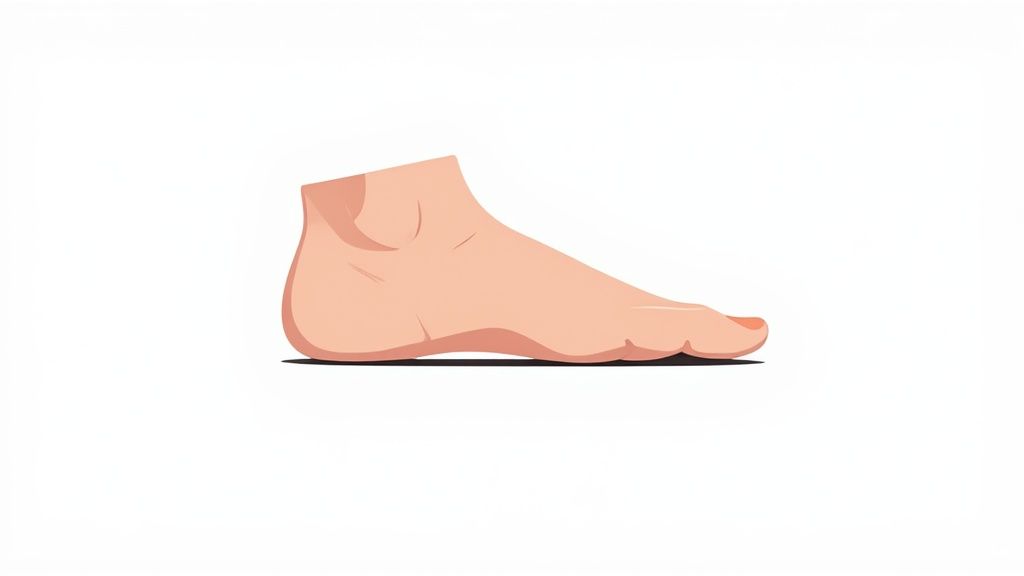
While things like ice can calm the initial storm of pain, consistent and targeted stretching is what truly sets you up for lasting recovery. If you're wondering how to really help your plantar fasciitis, stretching is non-negotiable. But it's not just about going through the motions; doing the right stretches correctly makes all the difference.
The goal isn't to force your foot into submission. It's about gently coaxing those tight, angry tissues into a more relaxed and flexible state. There’s a direct and powerful link between tight calf muscles and that stabbing heel pain. When your calves are tight, they pull on your Achilles tendon, which then cranks up the tension on your plantar fascia. Releasing that tension in your calves gives your foot immediate, direct relief.
The Essential Wall Calf Stretch
This classic stretch is popular for a reason—it simply works. With a few small tweaks to your form, you can turn this simple movement into a powerful tool for relief.
First, find a solid wall and stand about an's length away from it. Step forward with one foot flat on the floor, and extend your other leg straight back, making sure to plant your heel firmly on the ground.
Now, lean forward and place your hands on the wall for support. You should feel a gentle but firm stretch in the calf of your back leg. The key is to keep that back leg straight and your heel glued to the floor. Hold this position for a solid 30 seconds. Whatever you do, don't bounce. Bouncing can create tiny tears in the muscle, which will only set you back.
Slowly release the stretch, switch legs, and do it all again. I always recommend aiming for three repetitions on each leg.
Pro Tip: To hit the lower part of your calf (the soleus muscle), try this variation. While in the stretch, slightly bend the knee of your back leg but keep your heel planted. This subtle change shifts the stretch to a different muscle group that also plays a big role in plantar fascia tension.
Master the Seated Towel Stretch
This one is a lifesaver first thing in the morning. It's the perfect way to prepare your plantar fascia for those dreaded first steps out of bed.
Sit on the floor or on the edge of your bed with your legs straight out in front of you. Grab a towel, a yoga strap, or even a belt and loop it around the ball of the foot that's giving you trouble. Gently pull the towel toward your body, keeping your knee straight. You should feel a good stretch in your calf and all along the bottom of your foot.
Hold it steady for 30 seconds—no jerking or bouncing. Release slowly and repeat it three times. Making this simple stretch part of your morning routine can dramatically reduce that sharp, stabbing pain that so often comes with the first steps of the day.
This focus on stretching isn't just for athletes. Our jobs and daily lives are huge contributors to foot pain. For example, studies on healthcare workers show a clear link between standing for long hours and wearing the wrong shoes, which significantly increases stress on the plantar fascia. These findings really highlight why preventative measures like daily stretching are so critical, especially for people who are on their feet all day. You can read more about the impact of occupational factors on foot health in this study.
Gentle Foot Rolling for Targeted Relief
We mentioned using a frozen bottle for acute pain, but for a more targeted stretch, a small, firm ball is your best friend. A lacrosse ball or a dedicated massage ball works perfectly. This is less about a general massage and more about a focused release of the fascia itself.
- Sit comfortably in a chair and place the ball under the arch of your foot.
- Gently roll the ball from your heel to the ball of your foot.
- Apply steady, firm pressure, but back off if you feel any sharp pain.
- When you find an especially tender spot, just pause. Hold the pressure there for 20-30 seconds and let the tissue release.
Think of it like you're ironing out the wrinkles in your plantar fascia. Doing this for just a few minutes each day can help break down adhesions and improve the tissue's flexibility. This kind of consistent, mindful movement is your ticket to reducing pain and finally getting back on your feet without that constant dread.
Strong Feet Are Your Best Defense Against Future Pain
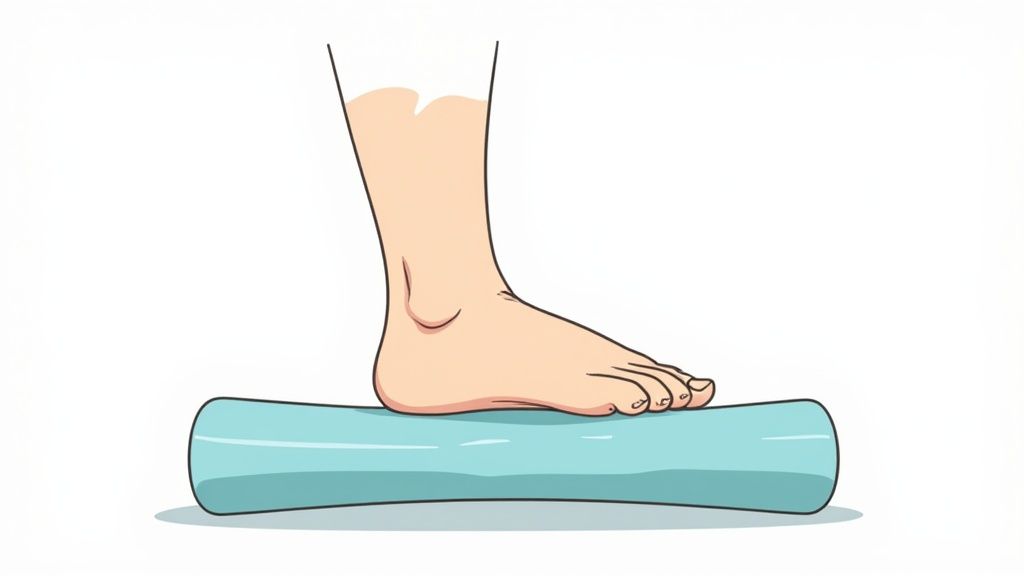
Stretching is great for immediate relief, but if you want to stop that heel pain from coming back, you need to build strength. Once the initial, intense inflammation calms down, your goal should be to make your feet more resilient. This is how you get rid of plantar fasciitis for good, not just for a little while.
Think of it this way: your plantar fascia is like a bowstring supporting your arch. When the small muscles in your feet—the intrinsic muscles—are weak, the fascia takes a beating with every single step. By strengthening these little muscles, you're essentially giving your foot its own built-in shock absorption system, taking the pressure off the fascia.
Easy Exercises You Can Do Anywhere
The best part is, you don't need a gym or fancy equipment for this. You can easily work these into your day while watching TV, sitting at your desk, or even waiting for the kettle to boil. Consistency beats intensity every time.
A classic for a reason is the Towel Curl. Sit down, put your bare feet on the floor, and place a small towel in front of them. Using just your toes, bunch up and pull the towel toward you. Then, push it back out. Aim for about 10-15 reps. You'll feel those tiny foot muscles firing up almost immediately.
Another great one is Marble Pickups. Scatter a few marbles (or Legos, or even kibble) on the floor next to a small bowl. Use your toes to pick them up one by one and drop them in the bowl. This is less about raw strength and more about improving dexterity and fine motor control in your feet.
Why This Works: From what I've seen, weak intrinsic foot muscles are one of the most common culprits behind plantar fasciitis. These tiny muscles are meant to support your arch and absorb impact. When they slack off, the plantar fascia gets overloaded, inflamed, and painful.
Taking Your Foot Strength to the Next Level
Once you’ve mastered the basics and they start to feel easy, you can move on to exercises that also challenge your balance. This doesn't just strengthen your feet; it strengthens everything up the chain, from your ankles to your hips.
Start with a simple Single-Leg Balance. Just stand on one foot and hold it for 30 seconds. Feeling steady? Close your eyes. Still too easy? Try balancing on a pillow. You'll be amazed at how hard your foot has to work to keep you upright.
You should also add in Calf Raises. Standing on a flat surface, slowly rise up onto the balls of your feet, pause for a second at the top, and then slowly lower back down. Stronger calves provide better support for your entire lower leg and foot. Aim for 2-3 sets of 15 reps.
A few tips to keep in mind:
- Be Consistent: Try to do these exercises at least 3-4 times a week.
- No Sharp Pain: You should feel your muscles working, maybe a little burn, but never sharp, stabbing pain. If you do, stop.
- Be Patient: Building strength takes time. You're playing the long game to keep flare-ups from happening again.
The road to recovery can feel like a long one, and it's totally normal to wonder when you'll feel better. For a better idea of what to expect, check out our guide on how long plantar fasciitis recovery typically takes.
This isn't about a quick fix. It's about building a stronger, more bulletproof foundation from the ground up. By spending just a few minutes a day on these simple moves, you're teaching your feet to support themselves properly again. This takes the daily strain off your plantar fascia, letting it finally heal and dramatically cutting the risk of that all-too-familiar pain coming back.
How to Choose the Right Footwear and Insoles
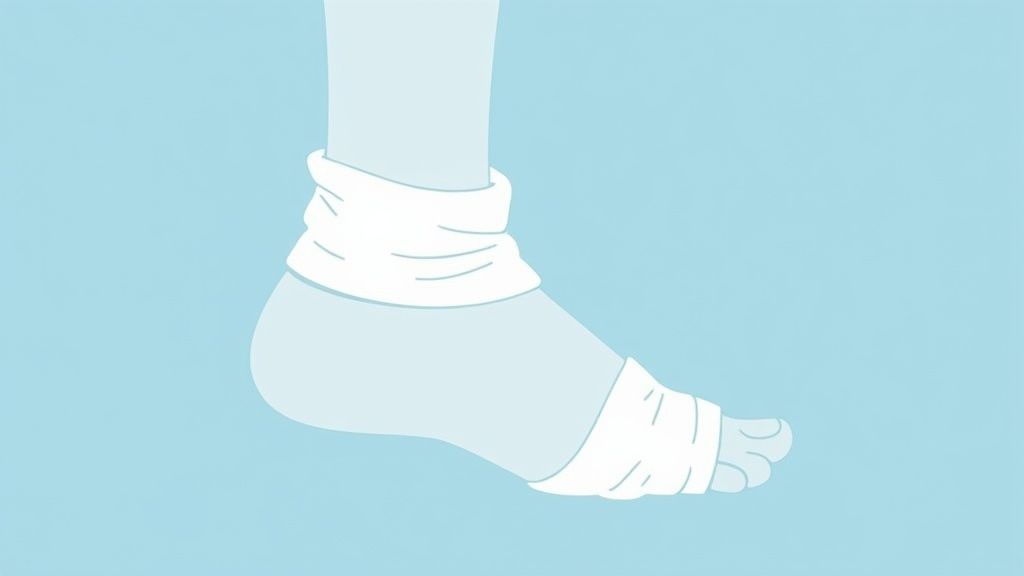
After you've put in the work with stretching and strengthening, the next critical piece of the puzzle is what you put on your feet every single day. I’ve seen it time and again: the right shoes can feel like a mobile treatment center for your feet. The wrong ones? They can undo all your hard work and keep your plantar fascia in a constant state of irritation.
It's a common mistake to think any soft, cushioned shoe will do the trick. But for plantar fasciitis, what you truly need is support, not just pillowy softness. Think of your shoes as a stable platform that prevents your foot from moving in ways that stress the fascia. This means it’s time to say goodbye to flimsy, flat footwear and embrace options that provide a solid, structured foundation.
Decoding a Supportive Shoe
When you're shopping for new shoes—whether for walking, work, or exercise—there are a few non-negotiable features to look for. Think of this as your new checklist for every pair you consider buying.
A firm heel counter is the first thing I tell people to check. That’s the part of the shoe that cups your heel. Go ahead and squeeze it. If it collapses easily, put the shoe back on the shelf. A stiff heel counter is crucial because it locks your heel in place, controlling motion and reducing stress on the fascia with every step you take.
Next, you need to test for torsional rigidity. This sounds technical, but it’s simple. Grab the shoe by the heel and toe and try to twist it like you're wringing out a wet towel. A good, supportive shoe will barely twist at all. This stability prevents your foot from over-rotating, which is a common trigger for plantar fascia strain.
Finally, make sure the shoe has a proper flex point. It should only bend where your foot naturally bends—at the ball of the foot. If you can fold the shoe in half in the middle of the arch, it offers zero support and will likely make your pain worse.
To make this easier, here's a quick reference table you can use when you're out shoe shopping.
Supportive Shoe Features Checklist
| Key Feature | What to Look For | Why It's Important |
|---|---|---|
| Firm Heel Counter | The back of the shoe shouldn't collapse when you squeeze it. | Stabilizes the heel to control excess motion and reduce strain. |
| Torsional Rigidity | The shoe resists twisting when you try to wring it out. | Prevents the foot from over-rotating and stressing the plantar fascia. |
| Proper Flex Point | The shoe only bends at the ball of the foot, not in the arch. | Mimics the foot's natural movement while providing crucial arch support. |
Having a shoe that ticks all these boxes creates the right environment for your foot to start healing.
The Role of Insoles: Your Secret Weapon
Even the best shoes might not have the exact arch support your specific foot needs. This is where high-quality insoles become your secret weapon in the fight against heel pain. They deliver targeted support right where your plantar fascia needs it most.
For many people, a well-designed over-the-counter insole is all it takes to feel a massive difference. I'm not talking about the squishy, gel-filled cushions you find at the drugstore. A truly effective insole, like a Samurai Insole, is biomechanically engineered to control overpronation—that inward rolling of the foot that is a major cause of plantar fasciitis.
These insoles work by supporting your arch and cradling your heel, which helps correct your foot's alignment with every step. This simple adjustment redistributes pressure away from your inflamed plantar fascia, giving it the break it desperately needs to heal. While custom orthotics are an option, they're often expensive and typically reserved for more complex foot issues.
Key Takeaway: Supportive insoles aren't just about comfort; they're about correction. By controlling harmful foot motion and properly supporting the arch, they address one of the root causes of plantar fasciitis, turning your everyday shoes into a powerful therapeutic tool.
Managing this condition isn't cheap. Plantar fasciitis creates a substantial economic burden, with the estimated national cost for treatment in the United States hovering around $284 million annually. In fact, about 93% of adults with this condition spend money every single month managing their pain. This just highlights how chronic the problem can be and why finding effective, lasting solutions like supportive insoles is so important.
The support from a quality insole is especially beneficial if you have a specific foot type, like flat feet, which are more prone to overpronation. If you suspect your foot structure is a contributing factor, you might be interested in our guide on how to choose the best shoe inserts for flat feet. This can help you find the perfect level of support for your unique needs.
When you pair a stable, supportive shoe with a high-quality orthotic insole, you create an environment where your foot can finally function correctly. This powerful combination reduces daily strain, calms inflammation, and builds a strong foundation for a pain-free life.
Smart Lifestyle Changes for Lasting Recovery
To truly get a handle on plantar fasciitis, we need to look beyond just stretches and insoles. Your daily habits and lifestyle choices are huge pieces of the puzzle. They can either help you heal for good or keep you stuck in a frustrating cycle of pain.
Making a few smart, practical adjustments can make all the difference. It's about creating an environment where your plantar fascia can finally catch a break and properly heal, building a more resilient foundation against future flare-ups.
Modify Your Activities, Not Your Life
Getting a plantar fasciitis diagnosis doesn't mean you're sentenced to the couch. In fact, staying active is crucial. The real secret is learning to modify your activities, not cut them out completely.
If you’re a runner, this might be a tough pill to swallow, but pounding the pavement is one of the worst things you can do for an inflamed fascia. Instead of giving up on cardio, just swap out the high-impact stuff for things that are a little kinder to your feet.
Here are a few great swaps:
- Swimming: This is the ultimate zero-impact exercise. You get a fantastic full-body workout without putting any stress on your feet.
- Cycling: Whether you're on a stationary bike or cruising outside, cycling keeps your feet supported while getting your heart rate up.
- Elliptical Trainer: This machine gives you a similar motion to running but without the jarring impact, making it a perfect substitute.
Real-World Scenario: I once worked with a dedicated marathon runner who was devastated by her diagnosis. Instead of quitting, she switched to deep-water running and cycling for two months. This allowed her to keep her fitness base while her foot healed. When she finally returned to running, she eased back into it and was completely pain-free.
The Impact of Weight on Your Feet
This can be a sensitive topic, but it’s one of the most important factors in getting better. Your feet support your entire body with every single step. For every extra pound you carry, the force on your feet increases significantly, especially when you're walking or running.
Research has shown that even a modest weight loss of just 5-10% of your body weight can dramatically reduce the strain on your plantar fascia. It’s like permanently lightening the heavy cargo your feet have to lug around all day, which helps calm down the inflammation and pain.
Eating an anti-inflammatory diet can be a great two-for-one strategy here. It helps with weight management while also directly fighting the inflammation at the heart of plantar fasciitis. You can explore plenty of foods to reduce inflammation that will support your recovery and overall health.
Strategies for People on Their Feet All Day
For so many people—nurses, retail workers, factory staff—standing for eight hours straight isn't a choice; it's the job. That means you’re putting immense, repetitive strain on your feet day in and day out.
One of the best things you can do is invest in an anti-fatigue mat. These cushioned mats create a softer surface that encourages tiny, subtle movements in your leg muscles. This boosts circulation and takes a lot of pressure off your heels.
Also, be smart about your breaks. Don't just sit down. Use that time to elevate your feet or do a few gentle calf stretches to release some of that built-up tension.
Knowing When to See a Professional
Trying to fix this on your own is a great first step, but it's vital to know when it’s not enough. If you’ve been diligent with these strategies for several weeks and the pain just isn’t getting better—or it’s getting worse—it’s time to call in a professional.
Here are the clear signs it’s time to book an appointment:
- The pain is severe enough to mess up your daily life.
- You simply can't put weight on your foot.
- The pain is still there after weeks of consistent self-care.
- You're feeling any numbness or tingling, which could point to a different problem.
A podiatrist or physical therapist can give you an accurate diagnosis and create a treatment plan tailored just for you. They have access to advanced therapies that can make a real difference. For a complete look at all your recovery options, our guide on how to fix plantar fasciitis covers these professional treatments in more detail.
Don't let stubborn pain hold you back. Knowing when to ask for help is a sign of strength, not failure.
Common Questions About Plantar Fasciitis
If you're dealing with plantar fasciitis, you've probably got a lot of questions. That’s completely normal. Getting clear answers is the first step toward getting back on your feet, literally. Let’s cut through the confusion and tackle some of the most common things people wonder about.
How Long Does Plantar Fasciitis Take to Heal?
This is the big one, isn't it? The honest answer is: it depends. For most people who stick to a solid treatment plan, you're likely looking at significant improvement within six to ten months. The key word there is stick. Your recovery speed really hinges on how consistent you are with stretching, strengthening exercises, and wearing the right footwear.
Some folks get lucky and feel relief in just a few weeks, especially if they catch the problem early. For others, particularly if the issue has become chronic, it can be a longer road. Patience is your best friend here.
Can I Still Exercise with Plantar Fasciitis?
You bet, but you’ll need to make some smart adjustments. The goal is to swap out high-impact activities that hammer your heels for low-impact exercises. Think of it as a strategic retreat to keep your fitness up without making your feet angrier.
Some great low-impact alternatives are:
- Swimming or water aerobics: The water takes all the pressure off.
- Cycling: A stationary bike or a leisurely ride outdoors is perfect.
- Elliptical machines: You get the motion of running without the jarring impact.
The Golden Rule: Your body will tell you what works. If you feel that sharp, stabbing pain in your heel, that’s your cue to stop. Pushing through it will only prolong your recovery.
Are Custom Orthotics Better Than Store-Bought Insoles?
Not always. It's a common misconception that custom-made automatically means better. While custom orthotics can be necessary for complex foot issues, they're often expensive and might be more than you actually need. A well-designed, over-the-counter insole can often provide all the arch support and cushioning required for major relief.
The root cause of most plantar fasciitis cases is overpronation—that's when your foot rolls too far inward as you walk. High-quality prefabricated insoles are engineered specifically to correct this motion. My advice? Start with a proven, ready-made insole first. You can always explore custom options later if the pain just won't quit.
Is Walking Barefoot at Home Bad for My Feet?
For the most part, yes. Think about the floors in your home—tile, hardwood, or laminate. They're hard and unforgiving. When you walk barefoot on these surfaces, your plantar fascia has to absorb 100% of the impact with every single step, with zero support.
That constant strain can easily dial up the inflammation and pain, undoing all your hard work. If you love the barefoot feeling, try to keep it on soft surfaces like a very plush rug. A better strategy for how to help plantar fasciitis at home is to wear supportive house shoes or even just your regular shoes with good insoles. This one simple habit gives your feet the continuous support they need to heal.
Don't let unanswered questions stand in the way of feeling better. Giving your feet consistent, reliable support is one of the most important things you can do. Samurai Insoles are biomechanically designed to tackle overpronation head-on, relieving the strain on your plantar fascia and turning your shoes into a tool for recovery.
